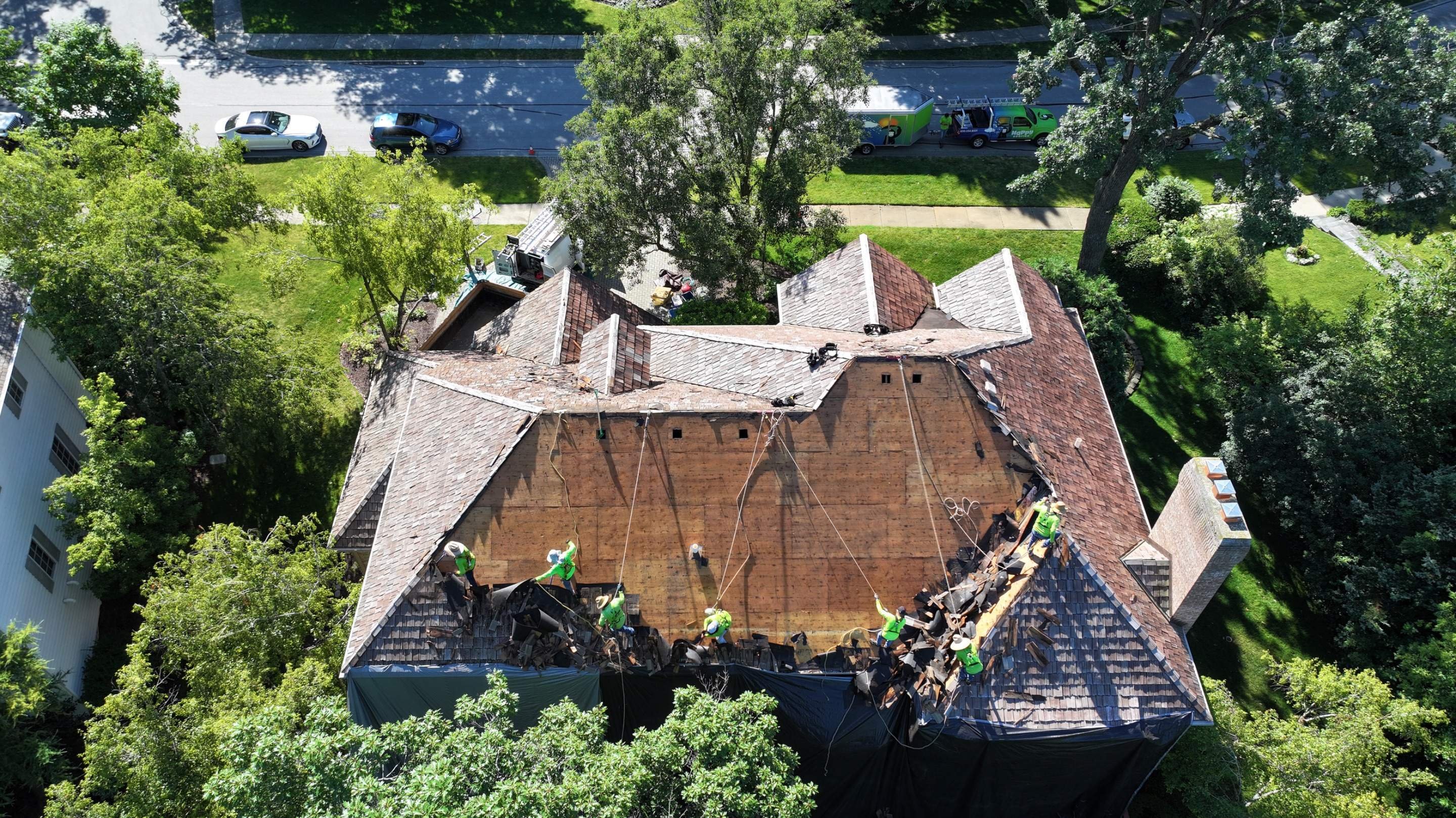Roof Repair vs. Replacement: What Naperville Homeowners Need to Know

Your roof is one of the most critical components of your home, but despite its size, it can be easy to overlook... until a problem arises.
Whether you've noticed a leak, spotted missing shingles, or simply suspect that age is catching up to your roof, you may find yourself asking: "Do I need a roof repair, or is it time to replace it entirely?"
At Happy Roofing, we've worked with countless homeowners facing this same decision in Naperville, IL, and the surrounding area. Our goal is to provide honest, helpful advice so you can make the right choice for your home, budget, and peace of mind. So, let's walk through what you need to know when weighing roof repair versus full replacement.
Table of Contents
- When Roof Repair is Better than Replacement
- When You Should Replace Your Roof
- How to Decide Between Roof Repair and Replacement
- How to Tell if a Roofing Contractor is Trustworthy
- Getting a Thorough Roofing Estimate
When Is Roof Repair Better Than Replacement?
Roof repairs can be a practical and cost-effective solution when the damage is minor or localized. For example, if a fallen branch has damaged a specific area of the roof or if a small leak is traced back to faulty flashing, a repair may be all that's needed.
Compared to roof replacements, repairs are generally:
- Less expensive: Repairing a small section of your roof costs a fraction of what a full replacement would. This can be ideal if your roof is otherwise in good condition and you’re not ready or don’t need to invest in a full overhaul.
- Faster to complete: Most roof repairs can be done in a single day, sometimes even in just a few hours. That means you can address the problem quickly without waiting for extensive scheduling, materials delivery, or weather delays.
- Less disruptive to your home life: Repairs don’t require tearing off your entire roof or removing layers of shingles. This means less noise, less debris, and less disruption for you and your family. If you're living in the home during construction, this can be a major advantage.
While roof repairs can be quick and cost-effective, one thing to keep in mind is aesthetics. It's not uncommon for new shingles to appear inconsistent with the color of existing materials due to wear, especially if your roof is several years old. This can result in a "patchy" or inconsistent look, which might affect curb appeal and have a negative impact on home value.
When done correctly, repairs won't weaken the rest of your roof, and they'll closely match the existing materials. In fact, they typically extend the lifespan of your roof (assuming it's still within its serviceable years) by addressing any damage that has the potential of spreading or becoming a more costly issue down the road.
When Should You Replace Your Roof Instead of Repairing It?
If your roof is nearing the end of its lifespan or experiencing widespread issues, replacement is often the smarter long-term investment. Sometimes, a localized repair isn't enough to stop leaks from returning, prevent further damage, or ensure the structural integrity of your roof.
Here are key signs it's time to consider a full replacement:
- The roof is 15–20 years old or older: Most asphalt shingle roofs are designed to last around 15-30 years. If yours is approaching or has passed that point, it may be more cost-effective to replace it rather than continue investing in frequent repairs.
- You find shingle granules in your gutters or downspouts: Granules are the protective coating on asphalt shingles that shield against UV rays, weather, fire, and other environmental hazards. When these sand-like particles start collecting in your gutters or downspouts in excessive amounts, it’s a clear sign your shingles are wearing down and your roof may be vulnerable to leaks and premature failure.
- The roof is sagging: A sagging roof could indicate trapped moisture, roof deck rot, and structural damage. This often requires a full replacement to correct and prevent further risk to your home’s safety.
- There are multiple leak points within the attic or other areas of the home: When leaks start appearing in more than one location, it suggests widespread failure rather than an isolated problem. At this stage, repeated repairs may only delay the inevitable and increase total costs over time.
- You’ve already had multiple repairs in recent years: If you've had to make multiple repairs within the last few years, it could be a sign that your roof is nearing the end of its lifespan. At that point, replacing the roof may offer more long-term value and reliability than continuing to patch individual issues.
In these cases, a full replacement is usually the smartest long-term solution. Repeated repairs on an aging roof can quickly add up, often costing more than simply installing a new one. Modern roofing materials and installation methods have made many advancements over the years, and replacing your roof may offer an opportunity to take advantage of some of these benefits in energy efficiency and durability if your roof is older.
Below is a photo demonstrating our work mid-replacement:

Roof Longevity & Maintenance
Once your roof is replaced, you'll be glad to know that if installed properly, it won't require much ongoing maintenance. Still, it's a good idea to have your roof inspected every five years or so. Early detection of minor issues can prevent more serious (and costly) problems later on.
The most important factor contributing to your roof's lifespan is the quality of installation. Whether you're repairing a small section or replacing the entire roof, choosing the right contractor can make all the difference. Proper installation ensures your roof performs as it should, lasts as long as possible, and protects your home from avoidable issues down the road.
How to Decide Between Roof Repair and Replacement
We know the idea of roof work can be overwhelming, especially when it's unclear what the best option is for your home. A trustworthy contractor will help you decide between roof repair and replacement without pressure, using a combination of expertise, visual evidence, and honest communication.
Here's what goes into a quality roof assessment:
- Thorough inspection: A good contractor will take time to evaluate your entire roofing system, including key components like vents, gutters, soffits, flashing, and attic ventilation. This ensures they're diagnosing the root cause, and not just treating symptoms.
- Visual documentation: Reputable contractors will show you exactly what they see using photos or videos, so you're not left guessing. Clear documentation helps you understand the issues and builds trust through transparency.
- Clear and honest recommendations: Instead of pushing a one-size-fits-all solution, a quality contractor will explain your options in detail based on the condition of your roof, your long-term goals, and your budget. Their goal should be helping you make the right decision, not the most profitable one.
We've put together a flowchart to help guide you towards the best option for your specific situation:

How Do I Know If a Roofing Contractor Is Trustworthy?
A trustworthy roofing contractor will make the inspection and decision-making process clear, transparent, and pressure-free. Unfortunately, not all contractors have your best interests in mind. Some may push for a full replacement despite repair being a suitable choice.
So how can you tell if a contractor is trustworthy? Here are some key points to consider when choosing a roofing contractor for you and your home:
- They take their time during the inspection and don't rush the process.
- They show you what they find rather than just tell you.
- They're transparent and communicative, walking you through the pros and cons of each option relating to your specific situation and goals.
If a contractor is unwilling to explain their recommendations or tries to pressure you into a decision, that's a red flag. Whether it's a repair or replacement, roof work comes at a significant cost investment, and your contractor should be sensitive to the decision-making process.
Protecting Yourself With the Right Roofing Estimate
Whether you choose repair or replacement, the estimate you receive should give you confidence rather than confusion. A good contractor will take time to explain the details, show you evidence of what needs to be done, and answer your questions openly. If an estimate feels rushed, vague, or if the contractor is overly pushy, that's a red flag.
Your roof is a major investment, and understanding how thorough estimates are built is one of the best ways to protect yourself from unnecessary costs or poor workmanship. If you want to see how the process should look, check out our guide: How Happy Roofing Builds an Honest Roofing Estimate (And How to Spot Red Flags). It will show you what to expect in a fair, transparent estimate before you commit to anything.
If you'd rather talk to someone immediately to help evaluate which solution may be best for your home, we offer no-commitment consultations. We'll assess your roof and provide you with all the information necessary to help you make a well-informed decision based on your long-term goals, with no further obligations.
The Author: Pedro Toledano
Happy Roofing is a trusted roofing company dedicated to providing top-quality roofing services to residential and commercial clients. With years of experience, they specialize in roof installations, repairs, and maintenance, ensuring durability and customer satisfaction. The team is known for their professional approach, timely service, and attention to detail. Happy Roofing prides itself on using high-quality materials and offering competitive pricing. Follow their Facebook page for updates on projects, customer testimonials, and tips on maintaining your roof in excellent condition.





